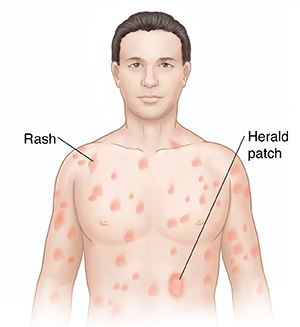
There have been various treatments that doctors have used to shorten the time that the rash is present. This can involve steroid creams applied to the skin, the use of ointments for itching, and oral antihistamines. Much of the treatment of the disease is related to reducing the level of itching the person is experiencing. Even if nothing is done in the way of treatment, the condition usually resolves itself within 1 to 3 months. The basic treatment of pityriasis rosea is to manage the symptoms and support the itching and other symptoms.
#Herald patch pityriasis rosea causes Patch#
Usually the herald patch gives away the fact that the disease is pityriasis rosea.
#Herald patch pityriasis rosea causes skin#
In the early pityriasis rosea stages, the doctor may perform biopsies or blood tests in order to see if the rash is from pityriasis rosea or if it is from some other kind of skin disease. You basically have to follow the pityriasis stages and take a careful history and physical examination of the skin. There is no blood or skin test that shows that you have pityriasis rosea. After the rash dissipates, you may have areas of dark or lightness of the skin that take months to disappear. Usually, the herald patch and the other skin patches will dissipate after 12 weeks, although it can take as many as five months before they disappear. If you sweat or wear tight clothing, the itching is usually worse. It can be mildly itchy or severely itchy. The rash doesn’t have to be painful but in many cases, it can itch. They form a “Christmas tree pattern” on the chest or back with all the patches spreading out from the center. In dark-skinned people, the patches can be dark brown or gray in color. In people who have light-skin, the patches tend to be reddish or pinkish in color. They occur primarily on the back, chest, neck, upper arms, belly, and upper thighs.

This type of rash is usually comprised of small, raised, and scaly patches that are about 0.5 to 1.5 centimeters in length. It comes on a few days to a couple of weeks after the herald patch shows up. Rash StageĪfter the herald patch comes the rash. The patch usually shows up in the areas mentioned above however, it can appear on the scalp, face, or genitals. It can be as little as 2 centimeters in diameter or as great as 10 centimeters in diameter (0.8 to 4 inches). It starts out as an oval lesion that grows over a few days’ time. This is a pityriasis rosea stage in which a large pink or salmon-colored patch shows up on the back, chest, or neck. These symptoms usually abate by the time the rash begins to show up. A fever of greater than 100.4 degrees Fahrenheit (38 degrees Celsius).Some of these signs and symptoms include the following: Preliminary Signs and SymptomsĪ few people with the disease will feel sick about a couple of days and up to two weeks prior to the appearance of the rash on the skin. Not everyone experiences all three stages. There are 3 stages of pityriasis rosea, each of which has different symptoms. When an autoimmune disease is believed to have occurred, the body makes antibodies against healthy, normal tissue for reasons that are not completely clear. It may be related to an autoimmune disease, according to some scientists. While it is believed to be viral in origin, doctors don’t believe that it is particularly contagious. It also appears to occur in clusters, suggesting a viral origin. This is one of the pityriasis rosea stages that occurs before any rash can be seen. Many sufferers have nonspecific and vague symptoms that precede the rash. There are several reasons why it is believed to be viral.


Many scientists believe that pityriasis rosea is a viral infection but no real viral pathogen has ever been found. No one knows the exact cause of pityriasis rosea it may be because of a virus. Pityriasis rosea starts in 60 percent to 90 percent of individuals with a herald patch, which is a salmon-colored or pinkish brown lesion that usually shows up on the neck, back, or chest. It has papulosquamous lesions that look like tiny, raised papules and scaly areas to the skin. It was first identified by Camille Gilbert, who was a French physician dating back to about 1860.

It is an extremely common skin condition and is completely benign. Pityriasis rosea is characterized by red lesions on the skin bordered by areas of skin that peel off in little scales. There are several pityriasis rosea stages that are identifiable by the findings on the skin. It results in patches of red on the skin and flaking of the skin. It is not related to rosacea, which is a chronic, incurable problem with the skin that usually affects adults. It is also known as “the Christmas tree rash”. Pityriasis rosea is a childhood skin problem that is extremely common.


 0 kommentar(er)
0 kommentar(er)
